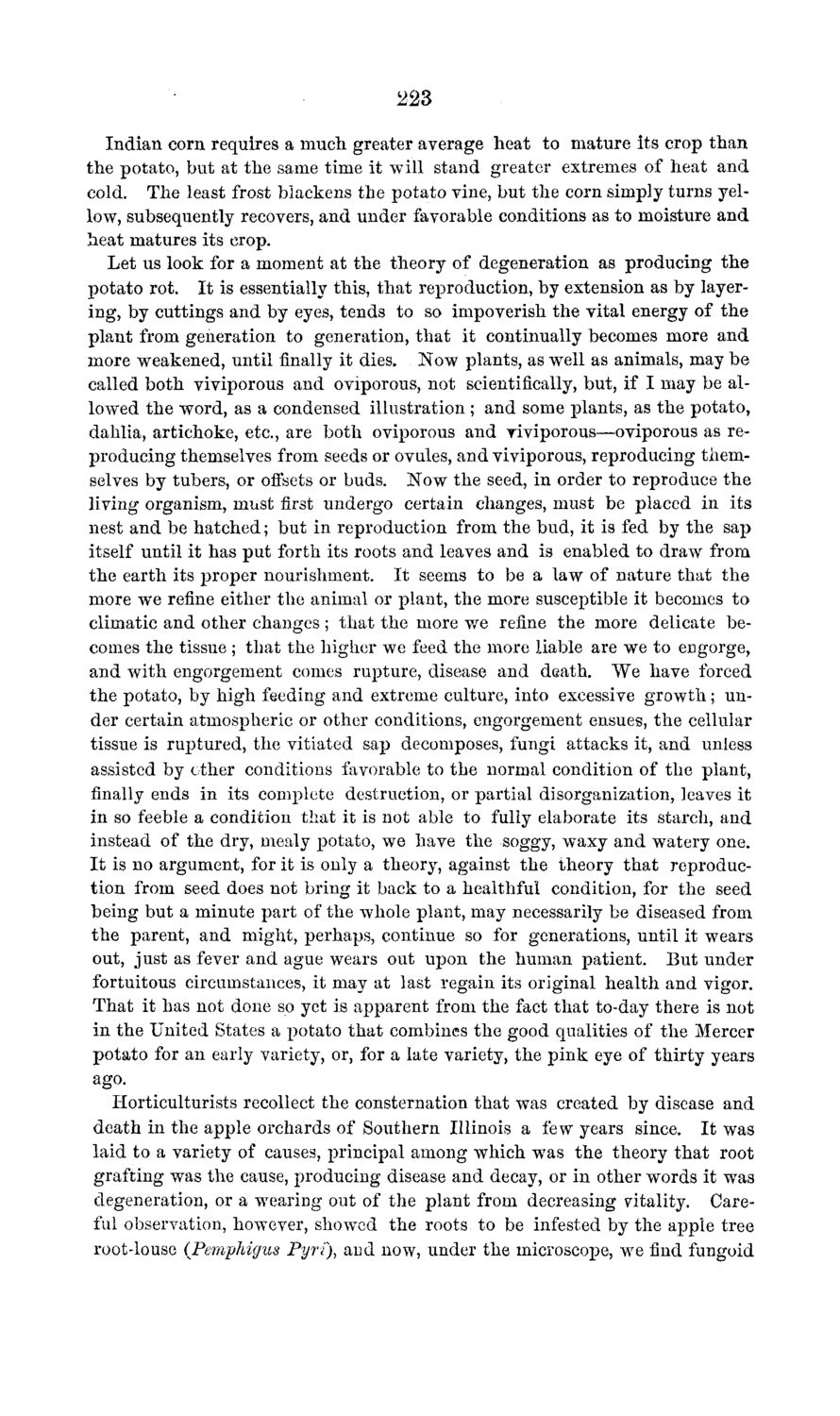| |
| |
Caption: Board of Trustees Minutes - 1869
This is a reduced-resolution page image for fast online browsing.

EXTRACTED TEXT FROM PAGE:
223 Indian corn requires a much greater average heat to mature its crop than the potato, but at the same time it will stand greater extremes of heat and cold. The least frost blackens the potato vine, but the corn simply turns yellow, subsequently recovers, and under favorable conditions as to moisture and heat matures its crop. Let us look for a moment at the theory of degeneration as producing t h e potato rot. It is essentially this, that reproduction, by extension as by layering, by cuttings and by eyes, tends to so impoverish the vital energy of t h e plant from generation to generation, that it continually becomes more and more weakened, until finally it dies. Now plants, as well as animals, may be called both viviporous and oviporous, not scientifically, but, if I may be allowed the word, as a condensed illustration ; and some plants, as the potato, dahlia, artichoke, etc., are both oviporous and viviporous—oviporous as reproducing themselves from seeds or ovules, and viviporous, reproducing themselves by tubers, or offsets or buds. Now the seed, in order to reproduce t h e living organism, must first undergo certain changes, must be placed in its nest and be hatched; but in reproduction from the bud, it is fed by the sap itself until it has put forth its roots and leaves and is enabled to draw from the earth its proper nourishment. It seems to be a law of nature that t h e more we refine either the animal or plant, the more susceptible it becomes to climatic and other changes ; that the more we refine the more delicate becomes the tissue ; that the higher we feed the more liable are we to engorge, and with engorgement comes rupture, disease and death. We have forced the potato, by high feeding and extreme culture, into excessive g r o w t h ; under certain atmospheric or other conditions, engorgement ensues, t h e cellular tissue is ruptured, the vitiated sap decomposes, fungi attacks it, and unless assisted by ether conditions favorable to the normal condition of the plant, finally ends in its complete destruction, or partial disorganization, leaves it in so feeble a condition t h a t it is not able to fully elaborate its starch, and instead of the dry, mealy potato, we have the soggy, waxy and watery one. I t is no argument, for it is only a theory, against the theory t h a t reproduction from seed does not bring it back to a healthful condition, for the seed being but a minute part of the whole plant, may necessarily be diseased from t h e parent, and might, perhaps, continue so for generations, until it wears out, just as fever and ague wears out upon the human patient. But under fortuitous circumstances, it may at last regain its original health and vigor. That it has not done so yet is apparent from the fact that to-day there is not in the United States a potato that combines the good qualities of the Mercer potato for an early variety, or, for a late variety, the p i n k eye of thirty years ago. Horticulturists recollect the consternation that was created by disease and death in the apple orchards of Southern Illinois a few years since. I t was laid to a variety of causes, principal among which was the theory that root grafting was the cause, producing disease and decay, or in other words it was degeneration, or a wearing out of the plant from decreasing vitality. Careful observation, however, showed the roots to be infested by the apple tree root-louse {Pemphigus Pyri)} and now, under the microscope, we find fungoid
| |